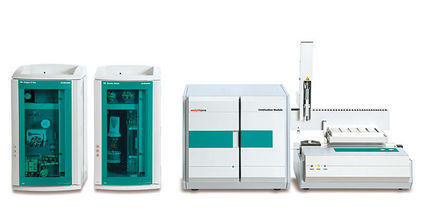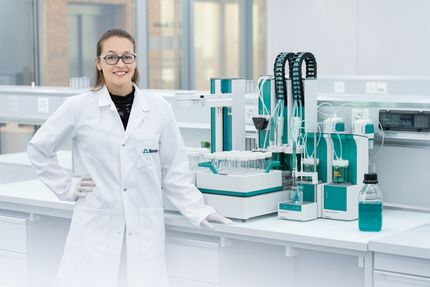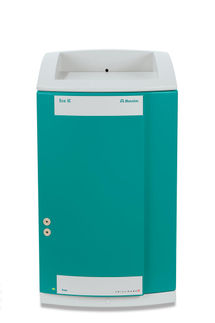The carbon cycle is the biogeochemical cycle by which carbon is exchanged between the biosphere, geosphere, hydrosphere, and atmosphere of the Earth.
The cycle is usually thought of as four major reservoirs of carbon interconnected by pathways of exchange. The reservoirs are the atmosphere, the terrestrial biosphere (which usually includes freshwater systems and non-living organic material, such as soil carbon), the oceans (which includes dissolved inorganic carbon and living and non-living marine biota), and the sediments (which includes fossil fuels). The annual movements of carbon, the carbon exchanges between reservoirs, occur because of various chemical, physical, geological, and biological processes. The ocean contains the largest active pool of carbon near the surface of the Earth, but the deep ocean part of this pool does not rapidly exchange with the atmosphere.
The global carbon budget is the balance of the exchanges (incomes and losses) of carbon between the carbon reservoirs or between one specific loop (e.g., atmosphere - biosphere) of the carbon cycle. An examination of the carbon budget of a pool or reservoir can provide information about whether the pool or reservoir is functioning as a source or sink for carbon dioxide.
In the atmosphere
Carbon exists in the Earth's atmosphere primarily as the gas carbon dioxide (CO2). Although it is a very small part of the atmosphere overall (approximately 0.04% on a molar basis, though rising), it plays an important role in supporting life. Other gases containing carbon in the atmosphere are methane and chlorofluorocarbons (the latter is entirely anthropogenic). The overall atmospheric concentration of these greenhouse gases has been increasing in recent decades, contributing to global warming.[1]
Carbon is taken from the atmosphere in several ways:
- When the sun is shining, plants perform photosynthesis to convert carbon dioxide into carbohydrates, releasing oxygen in the process. This process is most prolific in relatively new forests where tree growth is still rapid.
- At the surface of the oceans towards the poles, seawater becomes cooler and more carbonic acid is formed as CO2 becomes more soluble. This is coupled to the ocean's thermohaline circulation which transports dense surface water into the ocean's interior (see the entry on the solubility pump).
- In upper ocean areas of high biological productivity, organisms convert reduced carbon to tissues, or carbonates to hard body parts such as shells and tests. These are, respectively, oxidized (soft-tissue pump) and redissolved (carbonate pump) at lower average levels of the ocean than those at which they formed, resulting in a downward flow of carbon (see entry on the biological pump).
- The weathering of silicate rock. Carbonic acid reacts with weathered rock to produce bicarbonate ions. The bicarbonate ions produced are carried to the ocean, where they are used to make marine carbonates. Unlike dissolved CO2 in equilibrium or tissues which decay, weathering does not move the carbon into a reservoir from which it can readily return to the atmosphere.
Carbon can be released back into the atmosphere in many different ways,
- Through the respiration performed by plants and animals. This is an exothermic reaction and it involves the breaking down of glucose (or other organic molecules) into carbon dioxide and water.
- Through the decay of animal and plant matter. Fungi and bacteria break down the carbon compounds in dead animals and plants and convert the carbon to carbon dioxide if oxygen is present, or methane if not.
- Through combustion of organic material which oxidizes the carbon it contains, producing carbon dioxide (and other things, like water vapor). Burning fossil fuels such as coal, petroleum products, and natural gas releases carbon that has been stored in the geosphere for millions of years.
- Production of cement. Carbon dioxide is released when limestone (calcium carbonate) is heated to produce lime (calcium oxide), a component of cement.
- At the surface of the oceans where the water becomes warmer, dissolved carbon dioxide is released back into the atmosphere
- Volcanic eruptions and metamorphism release gases into the atmosphere. Volcanic gases are primarily water vapor, carbon dioxide and sulfur dioxide. The carbon dioxide released is roughly equal to the amount removed by silicate weathering; so the two processes, which are the chemical reverse of each other, sum to roughly zero, and do not affect the level of atmospheric carbon dioxide on time scales of less than about 100,000 yr.
In the biosphere
Around 1,900 gigatons of carbon are present in the biosphere.
Carbon is an essential part of life on Earth. It plays an important role in the structure, biochemistry, and nutrition of all living cells.
- Autotrophs are organisms that produce their own organic compounds using carbon dioxide from the air or water in which they live. To do this they require an external source of energy. Almost all autotrophs use solar radiation to provide this, and their production process is called photosynthesis. A small number of autotrophs exploit chemical energy sources in a process called chemosynthesis. The most important autotrophs for the carbon cycle are trees in forests on land and phytoplankton in the Earth's oceans. Photosynthesis follows the reaction 6CO2 + 6H2O → C6H12O6 + 6O2
- Carbon is transferred within the biosphere as heterotrophs feed on other organisms or their parts (e.g., fruits). This includes the uptake of dead organic material (detritus) by fungi and bacteria for fermentation or decay.
- Most carbon leaves the biosphere through respiration. When oxygen is present, aerobic respiration occurs, which releases carbon dioxide into the surrounding air or water, following the reaction C6H12O6 + 6O2 → 6CO2 + 6H2O. Otherwise, anaerobic respiration occurs and releases methane into the surrounding environment, which eventually makes its way into the atmosphere or hydrosphere (e.g., as marsh gas or flatulence).
- Burning of biomass (e.g. forest fires, wood used for heating, anything else organic) can also transfer substantial amounts of carbon to the atmosphere
- Carbon may also be circulated within the biosphere when dead organic matter (such as peat) becomes incorporated in the geosphere. Animal shells of calcium carbonate, in particular, may eventually become limestone through the process of sedimentation.
- Much remains to be learned about the cycling of carbon in the deep ocean. For example, a recent discovery is that larvacean mucus houses (commonly known as "sinkers") are created in such large numbers that they can deliver as much carbon to the deep ocean as has been previously detected by sediment traps.[2] Because of their size and composition, these houses are rarely collected in such traps, so most biogeochemical analyses have erroneously ignored them.
Carbon storage in the biosphere is influenced by a number of processes on different time-scales: while net primary productivity follows a diurnal and seasonal cycle, carbon can be stored up to several hundreds of years in trees and up to thousands of years in soils. Changes in those long term carbon pools (e.g. through de- or afforestation or through temperature-related changes in soil respiration) may thus affect global climate change.
In the oceans
The oceans contain around 36,000 gigatonnes of carbon, mostly in the form of bicarbonate ion. Inorganic carbon, that is carbon compounds with no carbon-carbon or carbon-hydrogen bonds, is important in its reactions within water. This carbon exchange becomes important in controlling pH in the ocean and can also vary as a source or sink for carbon. Carbon is readily exchanged between the atmosphere and ocean. In regions of oceanic upwelling, carbon is released to the atmosphere. Conversely, regions of downwelling transfer carbon (CO2) from the atmosphere to the ocean. When CO2 enters the ocean, carbonic acid is formed:
- CO2 + H2O ⇌ H2CO3
This reaction has a forward and reverse rate, that is it achieves a chemical equilibrium. Another reaction important in controlling oceanic pH levels is the release of hydrogen ions and bicarbonate. This reaction controls large changes in pH:
- H2CO3 ⇌ H+ + HCO3−
In the oceans, bicarbonate can combine with calcium to form limestone (calcium carbonate, CaCO3, with silica), which precipitates to the ocean floor. Limestone is the largest reservoir of carbon in the carbon cycle. The calcium comes from the weathering of calcium-silicate rocks, which causes the silicon in the rocks to combine with oxygen to form sand or quartz (silicon dioxide), leaving calcium ions available to form
limestone[3].
See also
References
- ^ The Intergovernmental Panel on Climate Change (IPCC) which represents wide consensus of international scientific opinion.
- ^ Monterey Bay Aquarium
Research Institute (MBARI) (2005-06-09). ""Sinkers" provide missing piece in deep-sea puzzle". Press release. Retrieved on 2007-10-07.
- ^ Notes, Lecture. The Carbon Cycle. Department of Atmospheric Sciences. University of Washington. Retrieved on 2007-12-21.
Further reading
- Appenzeller, Tim (2004). "The case of the missing carbon". National Geographic Magazine. - article about the missing carbon sink
- Bolin, Bert; Degens, E. T.; Kempe, S.; Ketner, P. (1979). The global carbon cycle. Chichester ; New York: Published on behalf of the Scientific Committee on Problems of the Environment (SCOPE) of the International Council of Scientific Unions (ICSU) by Wiley. ISBN 0471997102. Retrieved on 2007-10-07.
- Houghton, R. A. (2005). "The contemporary carbon cycle", in William H Schlesinger (editor): Biogeochemistry. Amsterdam: Elsevier Science, 473-513. ISBN 0080446426.
- Janzen, H. H. (2004). "Carbon cycling in earth systems—a soil science perspective". Agriculture, ecosystems and environment 104 (3): 399-417. doi:10.1016/j.agee.2004.01.040. ISSN 0167-8809.
|







